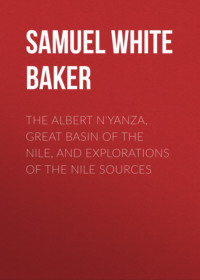 полная версия
полная версияWild Beasts and Their Ways, Reminiscences of Europe, Asia, Africa and America. Volume 1
The elephant, being in its wild state a nocturnal animal, must be able to distinguish the various qualities of trees by the senses of smell and touch, as in the darkness of a forest during night it would be impossible to distinguish the leaves. There are few creatures who possess so delicate a sense of smell; wild elephants will wind an enemy at a distance of a thousand yards, or even more, should the breeze be favourable. The nerves of the trunk are peculiarly sensitive, and although the skin is thick, the smallest substance can be discovered, and picked up by the tiny proboscis at the extremity.
A wound upon any portion of the trunk must occasion intense pain, and the animal instinctively coils the lower portion beneath its chest when attacked by a tiger. This delicacy of nerve renders the elephant exceedingly timid after being wounded, and it is a common and regrettable occurrence that an elephant which has been an excellent shikar animal before it has been injured, becomes useless to face a tiger after it has been badly clawed. I cannot understand the carelessness of an owner who thus permits a good elephant to work unprotected. In ancient days the elephants were armoured for warlike purposes to protect them from spears and javelins, and nothing can be easier than to arrange an elastic protective hood, which would effectually safeguard the trunk and head from the attack of any animal.
I had an excellent hood arranged for a large tusker which was lent to me by the Commissariat. The first layer of material was the soft but thick buff leather of sambur deer. This entirely covered the head, and was laced beneath the throat; at the same time it was secured by a broad leather strap and buckle around the neck. A covering for about three feet from the base of the trunk descended from the face and was also secured by lacing. The lower portion of the trunk was left unprotected, as the animal would immediately guard against danger by curling it up when attacked. Upon this groundwork of buff leather I had plates of thick and hard buffalo hide, tanned, overlapping like slates upon a roof. This armour was proof against either teeth or claws, as neither could hold upon the slippery and yielding hard surface of the leather tiles; at the same time the elephant could move its trunk with ease. Two circular apertures were cut out for the eyes, about six inches in diameter.
An elephant, if well trained, would be sufficiently sagacious to appreciate this protection should it find itself unharmed after a home charge by a tiger or other dangerous beast; and such a quality of armour would add immensely to its confidence and steadiness.
Although the elephant is of enormous strength it is more or less a delicate animal, and is subject to a variety of ailments. A common disease is a swelling in the throat, which in bad cases prevents it from feeding. Another complaint resembles gout in the legs, which swell to a distressing size, and give exquisite pain, especially when touched. This attack is frequently occasioned by allowing elephants, after a long march under a hot sun, to wade belly-deep in cool water in order to graze upon the aquatic vegetation.
Few animals suffer more from the sun's rays than the elephant, whose nature prompts it to seek the deepest shade. Its dark colour and immense surface attract an amount of heat which becomes almost insupportable to the unfortunate creature when forced to carry a heavy load during the hot season in India. Even without a greater weight than its rider, the elephant exhibits signs of distress when marching after 9 a.m. At such times it is disagreeable, as the animal has a peculiar habit of sucking water through the trunk from a supply contained within the stomach, and this it syringes with great force between its fore legs, and against its flanks to cool its sides with the ejected spray. The rider receives a portion of the fluid in his face, and as the action is repeated every five minutes, or less, the operation is annoying.
It is a curious peculiarity in the elephant that it is enabled to suck up water at discretion simply by doubling the trunk far down the throat, and the fluid thus procured has no disagreeable smell, although taken direct from the creature's stomach. In every way the elephant is superior to most animals in the freedom from any unpleasant odour. Its skin is sweet, and the hand retains no smell whatever, although you may have caressed the trunk or any other portion of the body. It is well known that a horse is exceedingly strong in odour, and that nothing is more objectionable than the close proximity of a stable, or even of a large number of horses picqueted in the open,—I have frequently been camped where fifty or sixty elephants were for several days in the same position within a hundred yards of the tents, and still there was no offensive scent.
The food of an elephant is always fresh and clean, and the digestive functions are extremely rapid. The mastication is a rough system of grinding, and the single stomach and exceedingly short intestines simplify the process of assimilation. The rapidity of the food passage necessitates a consumption of a large amount, and no less than six hundred pounds of fodder is the proper daily allowance for an elephant.
There have been frequent discussions upon the important subject of elephant-feeding. Mr. G. P. Sanderson, the superintendent of the keddah department in Assam, has declared against the necessity of allowing a ration of grain in addition to the usual fodder. This must naturally depend upon the quality of the green food. If the locality abounds in plantains, the stems of those plants are eagerly devoured, and every portion except the outside rind is nourishing. Even then the waste is excessive should the stems be heedlessly thrown down before the animal. It will immediately proceed to strip long fibrous ribbons from the stem by placing one foot upon the extremity, and then tearing off the alternate layers like the skin of an onion. These it converts into playthings, throwing them over its back and neck until it is dressed in dangling necklaces, which by degrees, after serving as toys, are ultimately devoured. The proper method of feeding an elephant with plantains where an allowance of rice is added, is by splitting the entire stem through the centre, and then cutting it into transverse sections about two feet in length. As each layer is detached, it resembles a delicately coloured trough, nearly white; this is doubled up in the centre and it at once forms a hollow tube, similar to a very thick drain tile. A handful of rice is placed within, and it is secured by tying with a fibrous strip from the plantain stem. A large pile of these neat packages is prepared for every elephant, and, when ready, the mahout sits by the heap and hands the parcels one by one to the ever-expectant trunk.
The delicacy of an elephant's palate is extraordinary, and the whims of the creature are absurd in the selection or rejection of morsels which it prefers or dislikes. I once saw a peculiar instance of this in an elephant that belonged to the police at Dhubri on the Brahmaputra. This animal had a large allowance of rice, therefore about three-quarters of a pound were placed within each tube of plantain stem. A lady offered the elephant, when being fed, a very small sweet biscuit, about an inch and a half in diameter. This was accepted in the trunk, but almost immediately rejected and thrown upon the ground. The mahout, fearing that his elephant had behaved rudely in thus refusing a present from a lady's hand, picked up the biscuit and inserted it in the next parcel of rice and plantain stem. This was placed within the elephant's mouth. At the first crunch the animal showed evident signs of disgust, and at once spat out the whole of the contents. There lay a complete ruin of the neat package, which had been burst by the power of the great jaws; but among the scattered rice that had been ejected we perceived the biscuit which had caused the second instance of bad behaviour. So utterly disgusted was the elephant with this tiny foreign substance that it endeavoured to cleanse its mouth from every grain of rice, as though polluted by the contact, and for several minutes it continued to insert its trunk and rake out each atom from its tongue and throat.
The adaptation of the trunk to many purposes is very interesting. I had an elephant who would eat every particle of rice in a round bamboo basket by sucking it up the trunk and then blowing it into its mouth. The basket was close-grained and smooth inside, but although brimful at the commencement of operations, it was emptied by the elephant as though it had been cleansed with a dry sponge.
A distinct rule for feeding elephants cannot be laid down without exceptions rendered necessary by peculiarities of localities and the amount of hard work required from the animal. If the elephant is simply turned out to grass for a season, it will thrive upon such natural herbage as bamboos, the foliage of the banyan, peepul, and other varieties of the Ficus family; but if it is expected to travel and perform good work, it is usual in the Commissariat department to allow each elephant seven and a half seers of flour, equal to 15 lbs. avoirdupois. In addition to this, 600 lbs. of green fodder are given, and about 1 lb. of ghee (buffalo butter), with salt and jaggery (native sugar). During a jungle expedition I have always doubled the allowance of flour to 30 lbs. daily for each animal. This is made into large flat cakes like Scotch "scones," weighing 2 lbs. each. The elephants are fed at about an hour before sunset, and then taken to drink water before actual night. Cleanliness is indispensable to the good health and condition of the elephant. It should bathe daily, and the entire body should be well scoured with a piece of brick or a soft quality of sandstone. This operation is much enjoyed, and the huge animal, obeying the command, lies down upon its side and accommodates its carcase to the scrubbing process by adapting its position to the requirements of the operator. It will frequently bury its head completely beneath the water, and merely protrude the extremity of its trunk to breathe above the surface. The coolie is most particular in scrubbing every portion of the animal, after which it will usually stand within the tank or river and shower volumes of water from its trunk over its back and flanks. When well washed, it appears a thoroughly clean black mass, but in a few minutes it proceeds to destroy its personal beauty by throwing clouds of dust upon its back, which, adhering to the moisture occasioned by its recent bath, converts the late clean animal into a brown mound of earth.
There is no quadruped not absolutely amphibious that is so thoroughly at home in the water as the elephant. In a wild state it will swim the largest rivers, and it delights in morasses, where it rolls in the deep mud like a pig or buffalo, and thus coats its hide with a covering of slime, which protects it from the attacks of flies and the worry of mosquitoes. When in a domestic state, the elephant is shy of trusting itself upon unsound earth or quicksands, as it appears to have lost the confidence resulting from an independent freedom among the jungles, and marshy valleys teeming with aquatic vegetation. It will also refuse to cross a bridge unless of solid masonry, and it is curious to observe the extreme care with which it sounds the structure, either by striking with the coiled extremity of the trunk or by experimenting with the pressure of one foot, before it ventures to trust its whole weight upon the suspected floor.
It is difficult to describe the limit of an elephant's swimming powers; this must depend upon many circumstances, whether it is following the stream or otherwise, but the animal can remain afloat for several hours without undue fatigue. The displacement of an elephant's carcase is less than the weight of water, although it swims so deeply immersed that it would appear to float with difficulty. An elephant shot dead within the water will float immediately, with a considerable portion of one flank raised so high above the surface that several men could be supported, as though upon a raft. The body of a hippopotamus will sink like a stone, and will not reappear upon the surface for about two hours, until the gas has to a certain degree distended the carcase: thus the hippopotamus is of a denser and heavier material than the elephant, although it is an aquatic animal.
When tame elephants cross a river they are conducted by their drivers, who stand upon their backs, either balancing themselves without assistance, or supported by holding a cord attached to the animal's neck. It is very interesting to watch the passage of a large river by a herd of these creatures, who to a stranger's eye would appear to be in danger of drowning, although in reality they are merely gamboling in the element which is their delight. I have seen them cross the Brahmaputra when the channel was about a mile in width. Forty elephants scrambled down the precipitous bank of alluvial deposit and river sand: this, although about thirty-five feet high, crumbled at once beneath the fore-foot of the leading elephant, and many tons detached from the surface quickly formed a steep incline. Squatting upon its hind-quarters, and tucking its hinder knees beneath its belly, while it supported its head upon its trunk and outstretched fore legs, it slid and scrambled to the bottom, accompanied by an avalanche of earth and dust, thus forming a good track for the following herd.
It is surprising to see in how few minutes a large herd of elephants descending a steep place will form a road. I have frequently seen them break down an alluvial cliff in the manner described, where at first sight I should have thought it impossible for an elephant to descend. Once within the river the fun began in earnest. After a march in the hot sun, it was delightful to bathe in the deep stream of the Brahmaputra, and the mighty forms splashed and disported themselves, sometimes totally submerged, with the drivers standing ankle-deep upon their hidden backs, which gave them the appearance of walking upon the surface. A tip of the trunk was always above water, and occasionally the animal would protrude the entire head, but only to plunge once more beneath the stream. In this way, swimming at great speed, and at the same time playing along their voyage, the herd crossed the broad river, and we saw their dusky forms glittering in the sunlight as they rose wetted from their bath, and waded majestically along the shallows to reach an island; from which they again started upon a similar journey to cross another channel of the river.
The first impression of a stranger when observing the conduct of a mahout or driver is sympathy for the animal, which is governed through the severe authority of the iron spike. This instrument is about twenty inches long, and resembles somewhat an old-fashioned boat-hook, being a sharp spike at the extremity beyond the keen-pointed hook; it can thus be used either to drive the elephant forward by digging the point into its head, or to pull it back by hooking on to the tender base of the ears. These driving-hooks weigh from about 4 to 6 lbs., and are formidable weapons; some are exceedingly ancient, and have been preserved for a couple of centuries or more, such specimens being highly artistic, and first-rate examples of the blacksmith's work. Although we may commence our experience by pitying the animal that is subjected to such harsh treatment, we quickly discover that without the hook the elephant is like the donkey without the stick. The fact of his knowing that you possess the power, or propeller, is sufficient to ensure comparative obedience, but it would be impossible to direct the movements of an elephant by simple kindness without the power to inflict punishment. This fact alone will prove that the elephant does not serve man through affection, but that it is compelled through fear. It is curious to witness the absurd subjection of this mighty animal even by a child. I have frequently seen a small boy threaten a large elephant with a stick, and the animal has at once winced; and, curling the trunk between the legs, it has closed its eyes and exhibited every symptom of extreme terror when struck repeatedly upon the trunk and face. The male is generally more uncertain than the female. It would at first sight appear that for shooting purposes the bull elephant would be preferred for its greater strength and courage. There can be no doubt that a pair of long tusks is an important protection, and not only forms a defence against the attack of a tiger or other animal, but is valuable for offensive purposes; yet, notwithstanding this advantage, the female is generally preferred to the male, as being more docile and obedient.
The males differ in character, but they are mostly uncertain in temper during a period varying from two to four months every year. At such occurrences of disturbance the animal requires careful treatment, and the chains which shackle the fore legs should be of undoubted quality. Some elephants remain passive throughout the year, while others appear to be thoroughly demented, and, although at other seasons harmless, would, when "must," destroy their own attendant and wreak the direst mischief. At such a crisis the mahout must always be held responsible for accidents, as the animal, if properly watched and restrained, would be incapable of active movements, and would of course be comparatively harmless. Upon many occasions, through the neglect of the attendant, an elephant has been left unchained, or perhaps secured with an old chain that has been nearly worn through a link; the escape of the animal under such circumstances has led to frightful casualties, usually commencing with the destruction of the mahout, who may have attempted a recapture. The approach of the "must" period is immediately perceived by a peculiar exudation of an oily nature from a small duct upon either temple; this somewhat resembles coal-tar in consistence, and it occupies an area of about four inches square upon the surface of the skin. There is a decided odour in this secretion somewhat similar to the same exudation from the neck of the male camel.
I have known male elephants which were remarkably docile throughout all seasons, but even these had to be specially regarded during the period of "must," as there was no means of foretelling a sudden and unexpected outbreak of temper. Many males are at all times fretful, and these expend their ill-nature in various ways; if chained, they kick up the earth, and scatter the dust in all directions; they are never quiet for one moment throughout the day, but continue to swing their heads to and fro, and prick forward their ears, exhibiting a restlessness of spirit that is a sufficient warning to any stranger. Such elephants should always be approached with caution, and never directly in front, but at the side.
An elephant is frequently treacherous, and if the person should stand unheedingly before it, a sudden slap with the trunk might be the consequence. For the same reason, it would be dangerous to approach the heels of such an animal, as a kick from an elephant is rather an extensive movement, and it is extraordinary that so colossal a limb as the hind leg can be projected with such velocity, equalling that of a small pony.
Discussions have frequently arisen concerning the maximum speed of an elephant; this is difficult to decide exactly, as there can be no question that the animal in a wild state will exert a greater speed than can be obtained from it when domesticated. The African variety is decidedly faster than the Asiatic; the legs being longer, the stride is in proportion; and as the habits of the African lead it to wander over large tracts of open country instead of confining its rambles to secluded forests, this peculiarity would naturally render the animal more active, and tend to accelerate its movements. I consider that the African elephant is capable of a speed of fifteen miles an hour, which it could keep up for two or three hundred yards, after which it would travel at about ten miles an hour, and actually accomplish the distance within that period. The Asiatic elephant might likewise attain a speed of fifteen miles for perhaps a couple of hundred yards, but it would not travel far at a greater pace than eight miles an hour, and it would reduce that pace to six after the first five miles.
The proof of an elephant's power of great speed for a short distance is seldom seen except in cases where the animal is infuriated, and gives chase to some unfortunate victim, who seldom escapes his fate by flight. For a short burst of fifty or one hundred yards an elephant might occasionally attain a pace exceeding fifteen miles an hour, as I have frequently, when among rough ground, experienced a difficulty in escaping when on horseback; and in my young days, when a good runner, I have been almost caught when racing along a level plain as smooth as a lawn with a savage elephant in full pursuit. An active man upon good ground can run for a short distance at the rate of eighteen miles an hour; this should clear him from the attack of most elephants; but unfortunately the good ground is scarce, and the elephant is generally discovered in a position peculiarly favourable to itself, where the roughness of the surface and the tangled herbage render it impossible for a man to run at full speed without falling.
We have recently seen a distressing example in the death of the lamented Mr. Ingram in Somaliland, who, although well mounted, was overtaken by an infuriated wild elephant and killed. This was a female, and it appears that Mr. Ingram, having followed her on horseback, had fired repeatedly with a rifle only .450. The animal charged, and owing to the impediments of the ground, which was covered with prickly aloes, the horse could not escape, and Mr. Ingram was swept off the saddle and impaled upon the elephant's tusks.
The African differs from the Asiatic in the formation of ivory, the tusks of the former being both thicker and heavier; the females also possess tusks, whereas those of the Asiatic variety have merely embryo tusks, which do not project more than two or three inches beyond the lips. I had a tusk of an African elephant that weighed 149 lbs. I have seen in Khartoum a pair that weighed 300 lbs., and I saw a single tusk of 172 lbs. In 1874 a tusk was sold at the ivory sale in London that weighed 188 lbs. These specimens are exceptions to the general rule, as the average weight in a full-grown African male would be about 140 lbs. the pair, or 75 lbs. for one tusk and 65 lbs. for the fellow, which is specially employed for digging.
The African variety is an industrious digger, as it feeds upon the succulent roots of many trees, especially those of the mimosa family. The right tusk is generally used in these operations more than the left; accordingly it is lighter from continual wear, and it is known by the Arabs as the "hadam" or servant. As the African elephant is a root-eater it is far more destructive than the Asiatic. It is astonishing to observe the waste of trees that are upturned by a large herd of these animals, sometimes out of sheer wantonness, during their passage through a forest. The dense tops of mimosas are a great attraction, and there can be no doubt that elephants work collectively to dig out and to overthrow the trees that would be too large for the strength of a single animal. I have seen trees between two and three feet in diameter that have been felled for the sake of the roots and tender heads; these have shown unmistakable signs of an attack by several elephants, as the ground has been ploughed by tusks of different sizes to tear up the long straggling roots which were near the surface, and the deep marks of feet around the centre of operations, of various diameters, have proved the co-operation of members of the herd.
I once saw an elephant strike a large timber tree with its forehead to shake down the fruit. This was a peculiar example of the immense power that can be exerted when required. We were waiting near the margin of the White Nile, about half an hour before sunset, expecting the arrival of waterbuck, when a rumbling sound and a suppressed roar in the jungle were accompanied by the breaking of a branch, which denoted the approach of elephants. Presently they emerged from the forest in several directions, and one, which appeared to be the largest I had ever seen, advanced to within 120 yards of our position without perceiving us, as we were concealed behind a bush upon some rising ground close to the river's bank. This elephant had enormous tusks, but as we had only small-bore rifles, I was contented to watch, without disturbing the magnificent animal before me.









